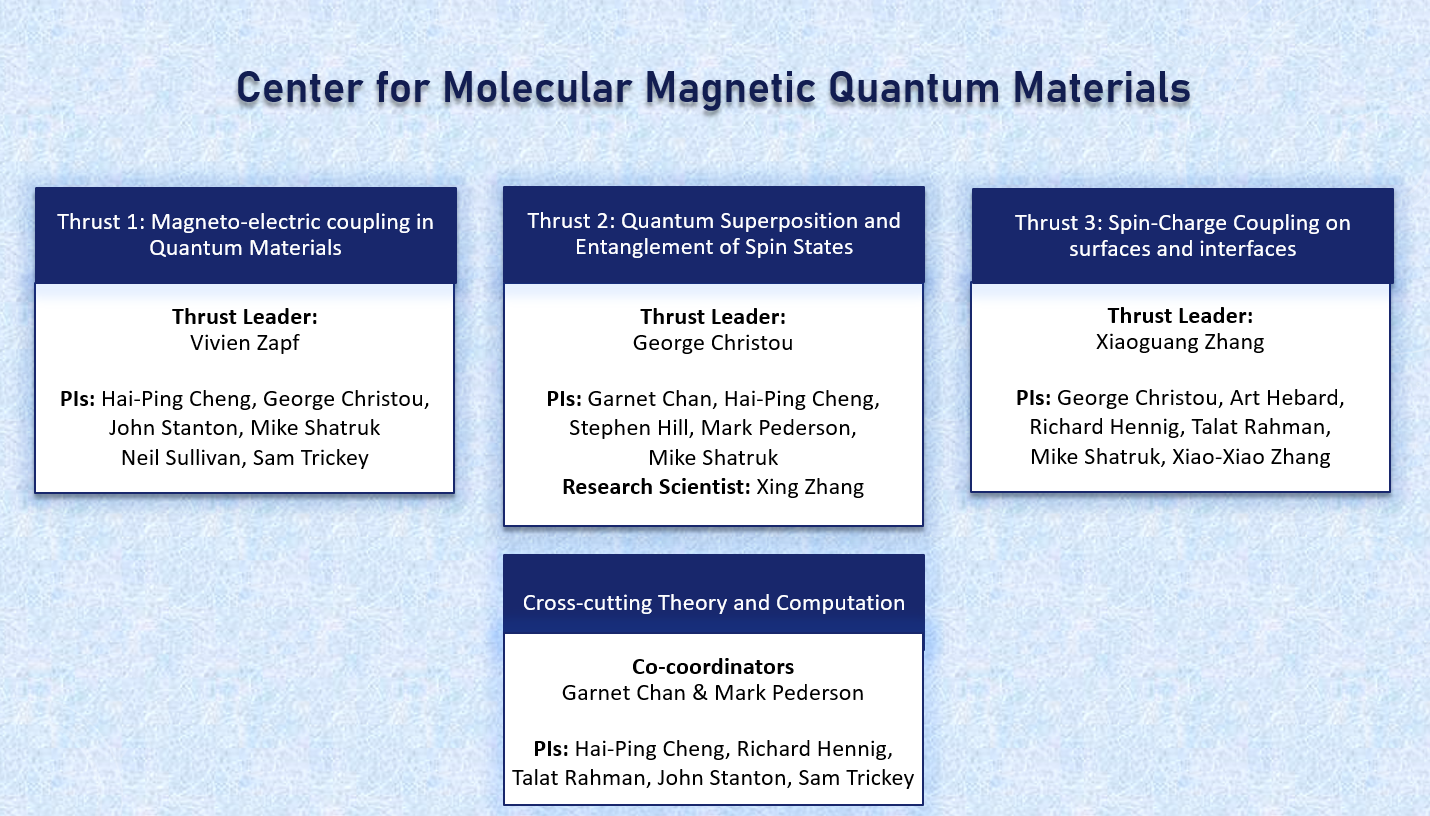M2QM Thrust Group Org Chart PDF
Thrust 1: Magneto-electric couplings in Quantum Materials
Team: Vivien Zapf (Lead), Hai-Ping Cheng, George Christou, Mike Shatruk, John Stanton, Neil Sullivan, Sam Trickey
Cross-Cutting Theory Collaborators: Hai-Ping Cheng and Xiaoguang Zhang are working with Vivien Zapf; Hai-Ping Cheng and Sam Trickey collaborate on software and method development
Overall Goals: Develop and understand magneto-electric coupling mechanisms in molecule-based magnetic materials. Develop enhanced computational tools for treating these phenomena. This work will advance our understanding of the quantum behavior of materials, including bosonic phases of spins, spin-orbit, and spin-charge-lattice couplings. A goal for applications is to sense, switch, and control the magnetic and electric state with voltages, currents, and magnetic fields.
Materials studied include:
– Molecule-based magnetic systems with antiferro/ferro magnetic order such as molecule based antiferromagnets like DTN, MOFs, etc.
– Single-molecule magnets in which electric properties will interrogate and control the Sz state of the molecule
– Molecules with spin crossovers in which low-spin to high-spin crossovers switch the structural and electric states of the material and vice versa
Thrust 2: Quantum Superposition and Entanglement of Molecular Spin States
Team: George Christou (Lead), Garnet Chan, Hai-Ping Cheng, Steve Hill, Mark Pederson, Mike Shatruk
Cross-Cutting Theory Collaborators: John Stanton together with Garnet Chan and Hai-Ping Cheng are working on benchmark calculations of a suite of dimers.
Overall Goals: Achieve a fundamental knowledge of quantum superposition and entanglement states generated by exchange-coupling between two or more magnetic molecules, and its sensitivity to external influences such as pressure. Develop magnetic molecules as multi-qubit systems and employ them to carry out quantum gate operations related to quantum computing.
Thrust 3: Spin-Charge Coupling on surfaces and interfaces
Team: Richard Hening (Lead) Xiaoguang Zhang (Lead), George Christou, Art Hebard, Richard Hennig, Talat Rahman, Mike Shatruk, Xiao-Xiao Zhang
Cross-Cutting Theory Collaborators: Hai-Ping Cheng is working with Xiaoguang Zhang on electron transport
Fundamental understanding of how couplings between molecules and substrates, molecules and external fields (non-equilibrium phenomena), molecules and probes, and between individual molecules affect quantum properties of molecular magnetic systems and of how to exploit such couplings in potential new technologies.
Material systems studied are magnetic molecules deposited on substrates
(A) Single molecule magnets (SMMs) to be studied:
1. Mn3 dimers
2. Mn12 with different electronegative ligands
3. Other molecules, e.g., Mn84 wheels
(B) Substrate configurations:
1. CVD graphene on back-gated oxidized silicon wafers
2. Insulating substrates prepatterned with interdigitated electrodes (IDEs)
3. Addressable cross-bar array configurations to address thickness-dependent coverage issues associated with SMM films.
4. Exfoliated topological insulators (TIs) from lab-available crystals (Bi2Se3, (Bi,Sb)Te2S, MnBi2Te4). Also, heterojunctions of same.
5. Single layer MoS2 on back-gated oxidized silicon wafers
6. Graphene on Si doped GaAs
7. Transition metal dichalcogenides (TMDCs) on Si doped GaAs
(C) Combining theoretical/computational and experimental methods to study
1. Structural stability of molecules on substrates
2. Electronic structure including charge transfer, effects of gating and dopants
3. Magnetic properties including moment, exchange coupling, spin-orbit coupling, susceptibility
4. Spin-lattice/phonon coupling
5. In-plane transport properties transport properties – carrier mobility, Hall effect, magnetoconductance, etc
6. Thin film magnetoconductance measurements to extract quantum corrections to the Boltzmann conductivity. A good starting point here is with graphene where these corrections have been well studied both in experiment and theory. Will SMMs have an effect?
7. Out of plane transport properties (capacitance, Schottky barriers, tunneling)
Fundamental Theory for Cross-cutting Research
Team: Mark Pederson (Lead), Garnet Chan, Hai-Ping Cheng, Richard Hennig, Talat Rahman, John Stanton, Sam Trickey, Xiaoguang Zhang
Each project must aim at underlying physics:
Predictive theory for spin-spin coupling, spin-phonon coupling, spin relaxation, SMM-surface coupling and proximity effect Software development that advances the foregoing capability requirements. To take maximum advantage of any generally applicable advances that are needed – for example, advances that are driven by one Thrust but can be used in another, or some development that requires several theory PIs to pull it off, theory needs a lead to coordinate activities.
Theory is not simply turning the crank. If we are not making significant theoretical advances that advance theory and modeling across the board, we are not doing our job. This is precisely the motivation for this crosscutting effort. It coincides with the spirit of over 20 years of advancements, driven by the scientific need and adopted by the community and by DOE/BES, in theory, modeling and simulation. Making theory a cross-cutting effort is a way to ensure theory will have the maximum impact across all Thrusts, while each Thrust has the full attention of the particular theorists in that Thrust.
